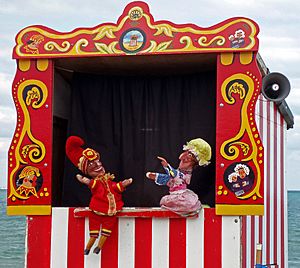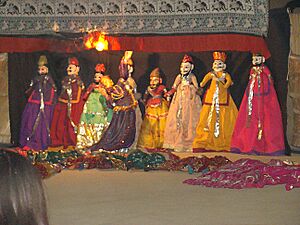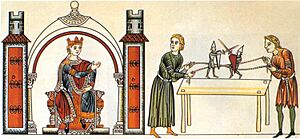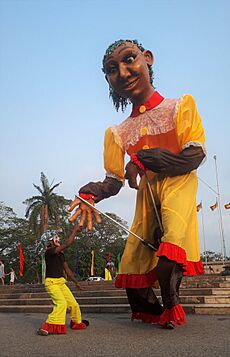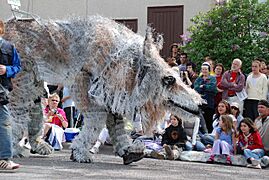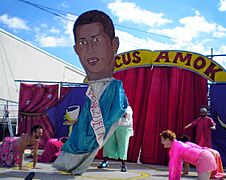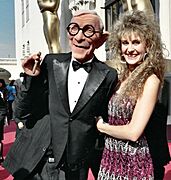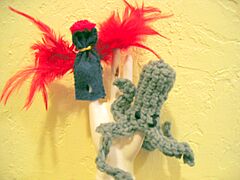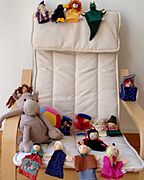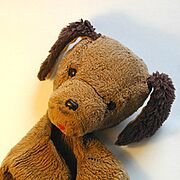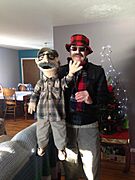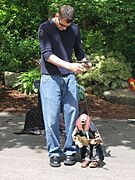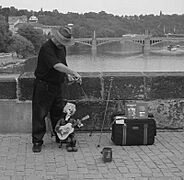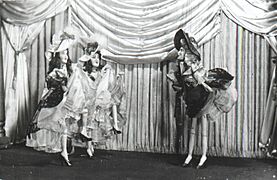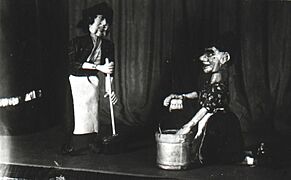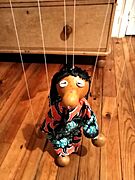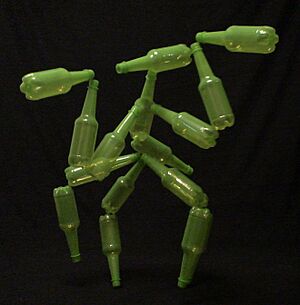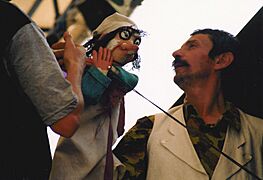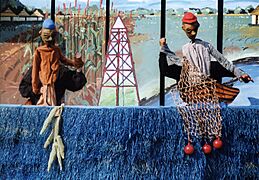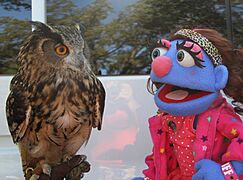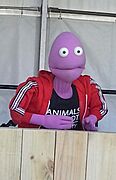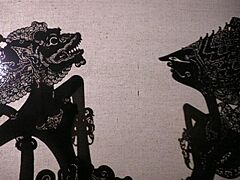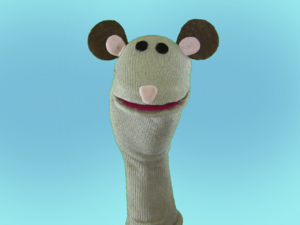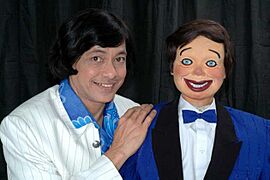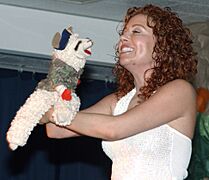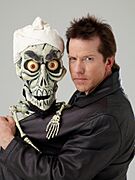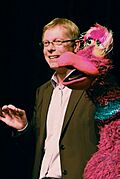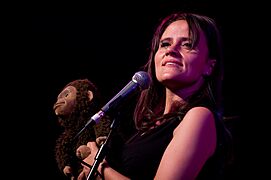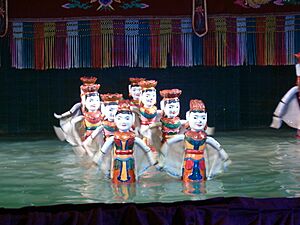Puppet facts for kids
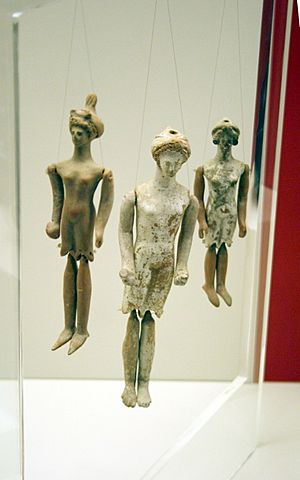
A puppet is an object that looks like a human, animal, or even a mythical creature. A person called a puppeteer makes the puppet move and seem alive. Puppetry is a very old type of theatre. It started way back in Ancient Greece around 500 BC.
There are many different kinds of puppets. They are made from all sorts of materials, depending on what they look like and how they will be used. Some puppets are very simple to make and use, while others are quite complex. The puppeteer uses their hands, arms, or special controls like rods or strings to move the puppet's body, head, arms, and sometimes even its mouth and eyes.
Often, the puppeteer will speak in the puppet's voice. They make the puppet's mouth move at the same time as they speak. Puppeteers use these actions, movements, and voices to tell stories.
Two simple types of puppets are the finger puppet and the sock puppet. A finger puppet is tiny and fits on just one finger. A sock puppet is made from a sock. You put your hand inside the sock, and opening and closing your hand makes the puppet's "mouth" move. The sock puppet is a type of hand puppet, which is controlled by one hand inside the puppet.
A "live-hand puppet" is bigger than a regular hand puppet. It needs two puppeteers to make it move. A marionette is a more complex puppet. It hangs from many strings connected to its head, back, and limbs. Sometimes, it also has a central rod. The puppeteer holds a control bar from above to move the strings.
A rod puppet has a main rod attached to its head. A shadow puppet is a flat shape cut out and held between a light and a screen. Bunraku puppets are special Japanese puppets carved from wood. A ventriloquist's dummy is a puppet, often shaped like a human. A ventriloquist makes the dummy "talk" without moving their own mouth much. This makes it seem like the puppet is really speaking. Carnival puppets are very large puppets, often bigger than a person. They are used in big shows or parades.
Contents
- Where Puppets Began
- Different Kinds of Puppets
- Black Light Puppets
- Bunraku Puppets
- Cantastoria
- Carnival and Body Puppets
- Finger Puppets
- Hand or Glove Puppets
- Human-Arm Puppets
- Light Curtain Puppets
- Marionettes
- Marotte
- Motekar
- Object Puppets
- Pull String Puppets
- Push Puppets
- Rod Puppets
- Shadow Puppets
- Sock Puppets
- Supermarionation
- Table Top Puppets
- Ticklebugs
- Toy Theatre
- Ventriloquist Dummies
- Water Puppets
- Rajasthani Puppets
- Puppets in Everyday Language
- See also
- Books and articles
Where Puppets Began
Puppetry was popular in Ancient Greece. The oldest written records about puppets come from the writers Herodotus and Xenophon, who lived in the 5th century BC. The Greek word for "puppet" is "νευρόσπαστος" (nevrospastos). This word means "drawn by strings" or "string-pulling." It comes from "νεῦρον" (nevron), which means "sinew, tendon, muscle, string," or "wire," and "σπάω" (spaō), which means "draw, pull."
Aristotle (who lived from 384 to 322 BC) wrote about puppets in his book On the Motion of Animals. He compared how animals move to how puppets work: "The movements of animals may be compared with those of automatic puppets, which are set going on the occasion of a tiny movement; the levers are released, and strike the twisted strings against one another."
In India, puppetry has been around since ancient times. It has different names in different parts of the country. Clay dolls found at Indus Valley sites suggest that puppetry was practiced there long ago. The art of puppetry called Bommalattam is even mentioned in old Tamil writings like Silappadikaram, from around the 2nd century BC.
Different Kinds of Puppets
Puppetry is a very creative art form. Many puppet groups combine different puppet styles and even use everyday objects in their shows. For example, they might use torn paper to look like snow, or a sign with words to help tell the story. Here are some of the main and most common types of puppets:
Black Light Puppets
A black light puppet show uses special ultraviolet lighting on stage. This lighting makes the puppets' colors glow brightly, but it hides the puppeteers. The puppets are usually made with colors that react to UV light. The puppeteers wear black clothes and perform against a black background, often made of black velvet. This way, they are invisible in the dark. The idea for this type of puppetry came from Bunraku puppetry.
Bunraku Puppets
Bunraku puppets are special puppets carved from wood. They were first made in Japan over a thousand years ago. They became more formal and were combined with shamisen music (a Japanese instrument) in the late 1500s. The puppeteers dress in black to blend into the background. However, their presence as "shadow" figures adds a mysterious feeling to the show. Bunraku puppets are usually one-third to one-half the size of a real person. It traditionally takes three puppeteers to operate one puppet.
Cantastoria
Cantastoria is a way of telling stories using visuals. A puppet, drawing, painting, or other visual item is shown while someone speaks or sings rhythmically. This describes or acts out the events of the story.
Carnival and Body Puppets
Carnival puppets (also called body puppets) are usually made for big shows. They are often seen in parades and demonstrations. These puppets are at least the size of a human, and often much bigger. One or more people are needed to move the puppet's body and limbs. In parades, the audience doesn't see the person inside the puppet. These puppets are famous in large entertainment events, like the nightly parades at Disney parks. Similar puppets were designed by Julie Taymor for The Lion King musical.
The Jim Henson Company also has its own version of these, called full-bodied puppets. Famous examples include Big Bird and Mr. Snuffleupagus from Sesame Street, and the main character from Bear in the Big Blue House. Mr. Snuffleupagus actually needs two puppeteers to make him move!
-
Carnival Puppet featuring two puppeteers - Minneapolis, USA: May Day Parade
-
Venezuelan President Hugo Chávez - human carnival puppet
-
Woman carrying body puppet of George Burns at 1988 Academy Awards
The Little Girl Giant Puppet was created to teach about female empowerment in Sri Lanka. This huge puppet was 14 feet tall! It was built by Swedish artist Felix Widen Norgren and Power of Play PVT LTD from Sri Lanka.
Finger Puppets
The finger puppet is a very simple puppet. It just fits onto a single finger. Finger puppets usually don't have moving parts. They are mostly a hollow tube shape that covers the finger. They are often decorated with eyes and mouths made from fabric. These puppets are mostly used in preschools or kindergartens for telling stories to young children.
Hand or Glove Puppets
-
British traditional hand or glove puppets, Punch and Judy
-
Simple sock puppets
-
Hand or glove puppet dog
A hand puppet (or glove puppet) is controlled by one hand inside the puppet. The famous Punch and Judy puppets are good examples of hand puppets. For larger hand puppets, the puppeteer's hand goes into the puppet's head to control the mouth and head. The puppet's body then hangs over the puppeteer's arm. Other parts, like the arms, are usually not much bigger than the hand itself. Often, the puppet's mouth can open and close. Some even have eyelids that can move. A sock puppet is a very simple type of hand puppet made from a sock.
Human-Arm Puppets
-
Oscar the Grouch and puppeteer Caroll Spinney
Also called a "two-man puppet" or "live-hand puppet," the human-arm puppet is bigger than a hand puppet and needs two puppeteers. One puppeteer puts their main hand inside the puppet's head to control its head and mouth. Their other hand goes into a special glove and sleeve attached to the puppet to move one arm. The second puppeteer puts their hand into another glove/sleeve to move the puppet's other arm. This allows the puppet to make hand gestures and pick up objects easily. This is a mix of glove and rod puppetry. Many puppeteers, especially those for Jim Henson's Muppets, start by helping with human-arm puppets. This is often called "right-handing."
Some of Henson's Muppets, like Fozzie Bear and Sesame Street characters Ernie and Count von Count, are live-hand puppets. So are Yoda and ALF. A different version, called a "sack-body" puppet, has the puppet's arms directly connected to its body. Famous examples include Sesame Street characters Cookie Monster and Oscar the Grouch, and the Muppet character Rowlf the Dog. The Swedish Chef, another Muppet, is unique because both of his hands are actual human hands, provided by a second performer. This technique of the main puppeteer doing the head and an assistant doing both arms is also used for Rowlf when he plays the piano.
Light Curtain Puppets
Light curtain puppet shows use light to highlight only small parts of the stage. This lets the audience see the puppet while the people moving it stay hidden. The puppets stand on a stage that has a dark background and a brightly lit front area. The light creates a "curtain" between them. The puppeteer wears black and stays hidden in the dark background. The puppet is held across the light curtain in the bright front part of the stage. This is a general term for any puppet that is moved into a bright area while its handler stays hidden by a division of light.
Marionettes
-
A puppeteer manipulating a marionette
-
A puppeteer manipulating a marionette in Prague, Czech Republic
-
Puppeteer performing in New Orleans, Louisiana
-
"The Giglet Sisters" posed on puppet theatre stage
-
"Uncle Rastus" an elderly man playing a banjo
-
Calabash puppet
-
Howdy Doody a popular marionette character
Marionettes, also known as "string puppets," hang from many strings. Sometimes they also have a central rod. These strings are connected to a control bar that the puppeteer holds from above. The control bar can be held either flat or upright. The main strings are usually attached to the puppet's head, back, hands (to move the arms), and just above the knees (to move the legs). This type of puppetry is complex and hard to do well. It needs more control than a finger, glove, or rod puppet. The puppet show that the Von Trapp children put on with Maria in The Sound of Music was a marionette show.
Some well-known marionette theaters today include: Salzberg Marionette Theater, Bob Baker Marionette Theater, Center for Puppetry Arts, Melchior Marionette Theater, the Swedish Cottage Marionette Theatre in Central Park, New York, and Le Theatre de Marionette.
Marotte
The marotte is a simple rod puppet that is just a head or body on a stick. Jesters used them during the Renaissance. In a marotte à main prenante, the puppeteer's other arm comes out of the puppet's body (which is just a cloth drape) to act as the puppet's arm. Some marottes have a small string running through the stick. When a handle at the bottom is squeezed, the puppet's mouth opens.
Motekar
Motekar or wayang motekar is a type of shadow puppet theater. In Sundanese, Javanese, and Indonesian, it's called 'wayang (kulit)', which means (leather) shadow puppet. Most shadow puppets create black shapes behind a screen. But motekar shadow puppets can be in full color! They use plastic materials, clear dyes, a special light system, and a special screen to make this happen. Motekar puppet shows can be performed by one or more puppeteers. They usually include music, singing, and dances.
Object Puppets
Not all puppet shows need specially made puppets. Object puppets can be created using everyday items found around us. These items can be put together before the show or even during the performance. Señor Wences was a Spanish ventriloquist who became famous on the American TV show The Ed Sullivan Show. His characters included Johnny (a face drawn on his hand) and Pedro (a grumpy head in a box). Pedro would "talk" when Wences opened the box. Similarly, chinface puppetry involves drawing or attaching puppet features onto an upside-down chin.
Pull String Puppets
A pull string puppet has a cloth body. The puppeteer puts their arm into a slot in the back. They pull rings on strings to make the puppet do certain movements, like waving its arms or moving its mouth.
Push Puppets
A push puppet has a body made of different parts on a base. It stays stiff until a button on the bottom is pressed. Then, the puppet wiggles, slumps, and falls down. Push puppets are usually just fun toys, not used in professional puppet shows.
Rod Puppets
-
Preparing a rod puppet for a performance of Town Musicians of Bremen, Sibiu, Romania, 2002.
A rod puppet is built around a main rod attached to its head. A large glove covers the rod and connects to the puppet's neck. The puppeteer controls a rod puppet by moving metal rods attached to the puppet's hands (or other limbs) and by turning the main rod connected to the head. The most famous examples of rod puppets are Jim Henson's Muppets, like Kermit the Frog, Miss Piggy, Gonzo, and others. Many Sesame Street characters, such as Elmo, Bert, Grover, and Abby Cadabby, are also rod puppets. The main characters from Fraggle Rock are too.
Shadow Puppets
-
Shadow Puppets, Jakarta, Indonesia
A shadow puppet is a flat shape cut out and held between a light source and a see-through screen. Shadow puppets can make solid dark shapes, or they can have cut-out details. Colors can be added to the cut-out parts for different effects. Moving the puppet or the light source can also change how it looks. Javanese shadow puppets, known as Wayang Kulit, are a classic example of this. In China, shadow puppetry became popular during the Song Dynasty.
Sock Puppets
A sock puppet is a puppet made and moved by putting a hand inside a sock. The hand opens and closes to make the puppet's "mouth" move, making it seem like it's talking. Sometimes, eyes and other face parts are added to the sock to make the puppet look more real. Sock puppets are popular in many puppet shows because they are simple to make and easy to use. They are often used in funny shows or for children's entertainment.
Supermarionation
Supermarionation is a special way of doing puppetry invented by Gerry Anderson. He used it in his TV shows like Stingray and Thunderbirds. The puppets were marionettes with mouths that moved electronically. This allowed them to match their mouth movements to the speech. Human puppeteers still controlled the marionettes with dark strings.
Table Top Puppets
A table top puppet is usually moved by a rod or by direct touch from behind. It performs on a surface like a table top, which is where it gets its name. It shares many features with Bunraku puppets.
Ticklebugs
A Ticklebug is a type of hand puppet made from a human hand. It looks like it has four legs. Puppet features are drawn right onto the hand. The middle finger is lifted to act as the head. The thumb and pointer finger become two legs on one side, while the ring finger and pinky finger become two legs on the other side.
Toy Theatre
The toy theatre uses puppets cut out of paper and glued onto card. The puppet is attached to a stick at its bottom. It is moved by pushing the stick in from the side of the puppet theatre. Sheets of puppets and scenery were made for children to use starting in the 1800s.
Ventriloquist Dummies
-
Edgar Bergen, with Charlie McCarthy, a famous American ventriloquist.
-
After Shari Lewis died, her daughter Mallory continued performing Lamb Chop.
-
Performers like Jeff Dunham, here with Achmed the Dead Terrorist, have made ventriloquism popular again.
The Ventriloquist's Dummy is a puppet shaped like a small human. A ventriloquist performer moves it to make the audience focus on the dummy, not the performer. This makes it seem like the dummy is really talking. They are called dummies because they don't speak on their own. The ventriloquist controls the dummy with one hand. Ventriloquism acts don't always use traditional dummies; sometimes other types of puppets are used.
Water Puppets
A water puppet is a Vietnamese puppet style called "Múa rối nước." This name means "dance underwater" or "dancing underwater." It's a very old tradition, going back to the 10th century. The puppets are made of wood, and the shows are performed in a pool of water that is waist-deep. A large rod supports the puppet under the water. Puppeteers use this rod to control them. It looks like the puppets are moving right on top of the water. When the rice fields would flood, villagers would entertain each other with this puppet show.
The water also helps tell traditional stories about daily village life. Water puppets show funny scenes of farming, fishing, and festivals like buffalo fights. They also show children playing games. Fishing often turns into a funny contest between the fisherman and his prey. Besides village life, the shows include legends and national history. Lion dogs play like puppies, while dragons breathe fire and smoke and spray water at the audience. Shows usually have up to 18 short scenes. A character named Teu, with a pig-tailed hairstyle, often introduces them. A small folk orchestra plays music during the performance.
Rajasthani Puppets
Rajasthani puppets have painted wooden heads. Their hands are made by stuffing cloth or cotton into the sleeves of their dresses. They have painted faces, angled eyebrows, mustaches for men, and nose rings for women. They also have big, expressive eyes. These puppets wear dresses made from old fabrics with sequins.
The puppeteers, known as "[Kathputliwalas]", are very skilled. They move the puppets and also provide voices and narration for the characters. They use their hands and feet to control the strings. Often, they perform with live music, using instruments like the dholak (a drum) and the sarangi (a string instrument).
Rajasthan [puppetry] shows usually have lively folk songs and dances. This creates a fun and exciting atmosphere. The stories in the puppet shows are often about historical events, old myths, social issues, and lessons about right and wrong. These performances are not just entertaining; they also share cultural and social messages with the audience.
Puppets in Everyday Language
The word puppet can also mean a political leader who is put in power, supported, and controlled by strong outside forces. This leader might not have been chosen by the people of their own country. In modern times, this usually means they weren't elected by the people. In older times, it could mean a king or queen put in power by an outside country, who wasn't part of the country's usual ruling family. "Puppet government," "puppet regime," and "puppet state" are negative terms for a government that is in charge of a place but is actually controlled by a more powerful outside government. An example is Vidkun Quisling, a Norwegian leader during World War II. He worked with Nazi Germany and led a puppet government.
More generally, a puppet can be any person who is controlled by another person. This might happen because of too much influence, not being smart enough, or not having a strong personality. The science fiction writer Robert A. Heinlein wrote a book called The Puppet Masters. In it, alien parasites attach themselves to humans and control what they do.
The word poppet sounds similar to puppet. It is sometimes used as a loving term, like "love," "pet," or "dear." It also relates to folk-magic and witchcraft. In these practices, a poppet is a special doll made to represent a person. It is used for casting healing, fertility, or binding spells.
On social media, "sock puppet" is a term for fake accounts. These accounts are used to spread false information, often about politics.
See also
 In Spanish: Títeres para niños
In Spanish: Títeres para niños
- List of highest grossing puppet films
- Animation
- Animatronics
- Das Spielhaus - East German puppet-based TV program
- Digital puppetry
- Jumping jack (toy)
- Karakuri ningyō - Mechanized puppets or automata from Japan
- Kenya Institute of Puppet Theatre (KIPT)
- Lübeck Museum of Theatre Puppets
- The Muppets, a cast of puppets from an American TV series.
- Pelham puppets
- Persian theatre
- Pierieliepiepielo
- Punch and Judy
- Puppetry
- Ventriloquist
- Ventriloquism
- Rajasthani Puppet - String marionettes originating from the state of Rajasthan in India
- Supermarionation - Advanced string puppetry techniques utilized in productions by AP Films
- State Puppet Theatre of Fairy Tales
Books and articles


